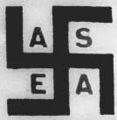Swastika
Jump to navigation
Jump to search
Swastika is a symbol found in many cultures, with different significance. Earliest use is traceable to the Neolithic period. In the West it is most known for its controversial usage as a Nazi symbol. In the East it is most known for its usage as a Hindu, Buddhist and Jain symbol of auspiciousness.
العربية: صليب معقوف
· Беларуская (тарашкевіца): Свастыка
· Български: Свастика
· Català: Esvàstica
· Dansk: Svastika
· Deutsch: Swastika, Hakenkreuz
· Eesti: Haakrist
· Ελληνικά: Σβάστικα
· English: Swastika
· Español: Esvástica
· Esperanto: Svastiko
· فارسی: صلیب شکسته
· Français : Svastika
· 한국어: 만자
· Hrvatski: Svastika
· Italiano: Svastica
· עברית: צלב הקרס
· Lietuvių: Svastika
· Magyar: Szvasztika
· Македонски: Свастика
· Nederlands: Swastika
· 日本語: ハーケンクロイツ
· Norsk bokmål: Hakekors
· Norsk nynorsk: Svastika
· Polski: Swastyka
· Português: Suástica
· Română: Svastică
· Русский: Свастика
· Српски / srpski: Свастика
· Srpskohrvatski / српскохрватски: Svastika
· Suomi: Hakaristi
· Svenska: Svastika
· Türkçe: Svastika
· 中文: 卐
· Contents
Geometry[edit]
Historical[edit]
Seals of the Indus Valley Civilization (Mature period 2600–1900 BCE)
Found from Nydam Mose (Nydam Bog) 200-400 A.D
Peruvian pre-hispanic vessel from the Sican/Lambayeque culture
Early 20th century[edit]
Western use of the Swastika in the early 20th century
ASEA logotype before 1933.
Finnish air forces roundel, used 1918-1945
Contemporary Eastern religions[edit]
Cover of a Chinese version of the Diamond Sutra
Nazism and Neo-Nazism[edit]

|
Legal disclaimer
This image shows (or resembles) a symbol that was used by the National Socialist (NSDAP/Nazi) government of Germany or an organization closely associated to it, or another party which has been banned by the Federal Constitutional Court of Germany. The use of insignia of organizations that have been banned in Germany (like the Nazi swastika or the arrow cross) are also illegal in Austria, Hungary, Poland, Czech Republic, France, Brazil, Israel, Ukraine, Russia and other countries, depending on context. In Germany, the applicable law is paragraph 86a of the criminal code (StGB), in Poland – Art. 256 of the criminal code (Dz.U. 1997 nr 88 poz. 553). |

































